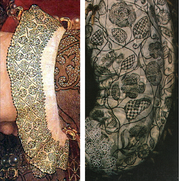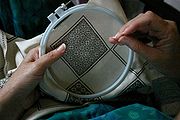
Blackwork Embroidery
Encyclopedia

Embroidery
Embroidery is the art or handicraft of decorating fabric or other materials with needle and thread or yarn. Embroidery may also incorporate other materials such as metal strips, pearls, beads, quills, and sequins....
using black thread. Sometimes it is counted-thread embroidery
Counted-thread embroidery
Counted-thread embroidery is any embroidery in which the fabric threads are counted by the embroiderer before inserting the needle into the fabric...
which is usually stitched on even-weave
Even-weave
Even-weave fabric or canvas is any woven textile where the warp and weft threads are of the same size.Even-weave fabrics are typically required as foundations for counted-thread embroidery styles such as cross-stitch, needlepoint, and blackwork so that a stitch of the same "count" will be the same...
fabric. Any black thread can be used, but firmly twisted threads give a better look than embroidery floss. Traditionally blackwork is stitched in silk
Silk
Silk is a natural protein fiber, some forms of which can be woven into textiles. The best-known type of silk is obtained from the cocoons of the larvae of the mulberry silkworm Bombyx mori reared in captivity...
thread on white or off-white linen
Linen
Linen is a textile made from the fibers of the flax plant, Linum usitatissimum. Linen is labor-intensive to manufacture, but when it is made into garments, it is valued for its exceptional coolness and freshness in hot weather....
or cotton
Cotton
Cotton is a soft, fluffy staple fiber that grows in a boll, or protective capsule, around the seeds of cotton plants of the genus Gossypium. The fiber is almost pure cellulose. The botanical purpose of cotton fiber is to aid in seed dispersal....
fabric. Sometimes metallic threads or coloured threads are used for accents.
Scarletwork is like blackwork, except it is sewn with red thread.
Technique
The stitches used for counted thread blackwork are double running or holbein stitchHolbein stitch
Holbein stitch is a simple, reversible line embroidery stitch most commonly used in Blackwork embroidery and Assisi embroidery. The stitch is named after Hans Holbein the Younger , a 16th-century portrait painter best known for his paintings of Henry VIII and his children, almost all of whom are...
, backstitch
Backstitch
Backstitch or back stitch and its variants stem stitch, outline stitch and split stitch are a class of embroidery and sewing stitches in which individual stitches are made backward to the general direction of sewing...
, and sometimes stem stitch. Historically it was done on plain weave fabric. Modern stitchers often use even weave fabric made especially for counted thread work.
Historically, there are three common styles of blackwork:
- In the earliest blackwork, counted stitches are worked to make a geometric or small floral pattern. Most modern blackwork is in this style, especially the commercially-produced patterns that are marketed for hobbyHobbyA hobby is a regular activity or interest that is undertaken for pleasure, typically done during one's leisure time.- Etymology :A hobby horse is a wooden or wickerwork toy made to be ridden just like a real horse...
stitchers.
- Later blackwork features large designs of flowers, fruit, and other patterns connected by curvilinear stems. These are frequently not counted thread work and are outlined with stem stitch, and the outlined patterns are filled with geometric counted designs.
- In the third style of blackwork, the outlined patterns are "shaded" with random stitches called seed stitches. This style of blackwork imitates etchings or woodcuts.
History

Chemise
The term chemise or shift can refer to the classic smock, or else can refer to certain modern types of women's undergarments and dresses...
in England from the time of Henry VIII
Henry VIII of England
Henry VIII was King of England from 21 April 1509 until his death. He was Lord, and later King, of Ireland, as well as continuing the nominal claim by the English monarchs to the Kingdom of France...
.
The common name "Spanish work" was based on the belief that Catherine of Aragon
Catherine of Aragon
Catherine of Aragon , also known as Katherine or Katharine, was Queen consort of England as the first wife of King Henry VIII of England and Princess of Wales as the wife to Arthur, Prince of Wales...
brought many blackwork garments with her from Spain, and portraits of the later 15th and early 16th centuries show black embroidery or other trim on Spanish chemises. Black embroidery was known in England before 1500. Geoffrey Chaucer
Geoffrey Chaucer
Geoffrey Chaucer , known as the Father of English literature, is widely considered the greatest English poet of the Middle Ages and was the first poet to have been buried in Poet's Corner of Westminster Abbey...
in the Canterbury Tales describes the clothing of the miller's wife, Alison: "Of white, too, was the dainty smock she wore, embroidered at the collar all about with coal-black silk, alike within and out."
Blackwork in silk on linen was the most common domestic embroidery technique for clothing (shirts, smocks, sleeves, ruffs
Ruff (clothing)
A ruff is an item of clothing worn in Western Europe from the mid-sixteenth century to the mid-seventeenth century.The ruff, which was worn by men, women and children, evolved from the small fabric ruffle at the drawstring neck of the shirt or chemise...
, and caps) and for household items such as cushion covers throughout the reign of Elizabeth I
Elizabeth I of England
Elizabeth I was queen regnant of England and Ireland from 17 November 1558 until her death. Sometimes called The Virgin Queen, Gloriana, or Good Queen Bess, Elizabeth was the fifth and last monarch of the Tudor dynasty...
, but it lost its popularity by the 17th century. (See also 1550–1600 in fashion.)
Historic blackwork embroidery is rarely preserved, as the iron-based dye used was corrosive to the thread.
Modern blackwork

Today, the term "Blackwork" is used to refer to the technique, rather than the colour combination.
External links
- A Blackwork Embroidery Primer
- Blackwork for Costume
- http://www.prettyimpressivestuff.com/stitches/holbein_files/holbein_frames.htm Holbein Stitch Diagram

